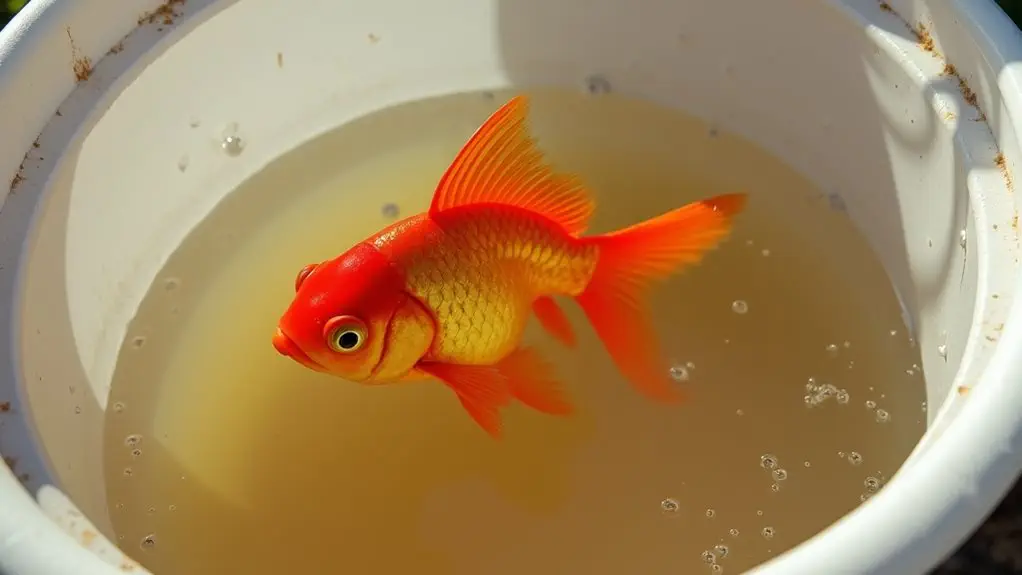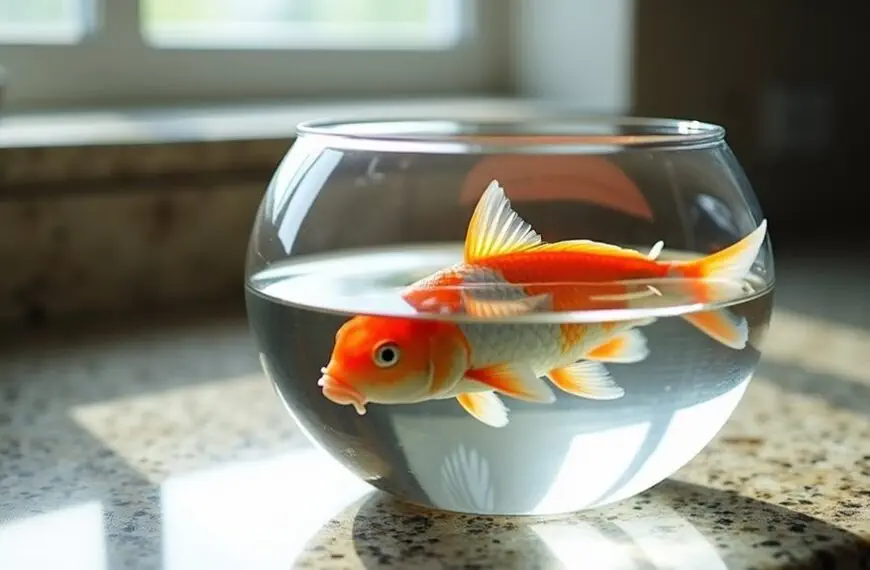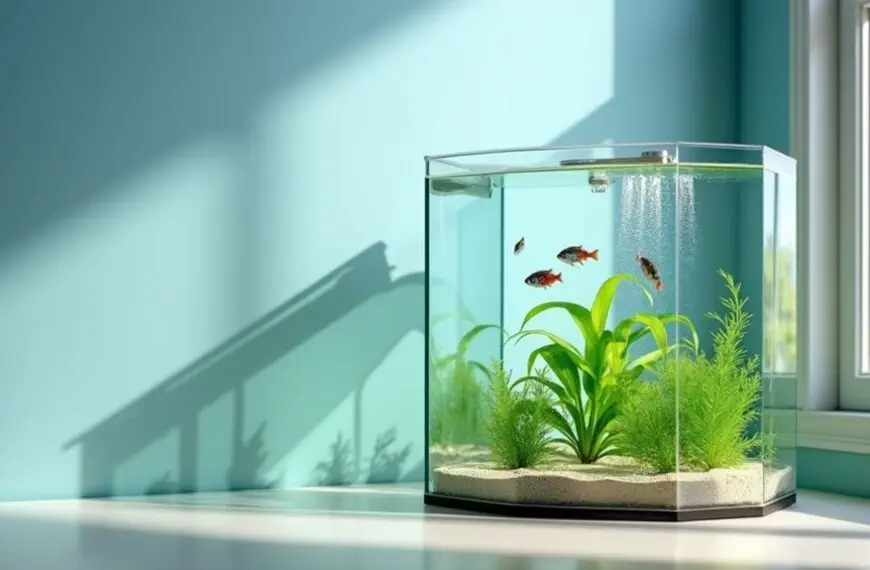You can keep goldfish in a bucket for up to 3-4 days maximum, but you'll need to monitor them closely and provide proper care. Fill the bucket two-thirds full with tank water, maintain a temperature between 65-75°F, and use a battery-operated air pump with an air stone for oxygen. Watch for signs of stress like gasping or erratic swimming, and check water quality every 4-6 hours. Don't overfeed during their bucket stay, and remember that a 5-gallon minimum per inch of fish length is essential. While buckets work for emergencies, there's much more to keeping your finned friends happy in temporary housing.
Contents
- 1 Safe Duration in Temporary Housing
- 2 Water Quality Requirements
- 3 Space and Size Considerations
- 4 Emergency Bucket Setup Essentials
- 5 Signs of Stressed Fish
- 6 Maintaining Proper Oxygen Levels
- 7 Feeding During Bucket Stays
- 8 Alternative Housing Options
- 9 Frequently Asked Questions
- 9.1 Can Goldfish Survive in a Bucket During Power Outages?
- 9.2 Should I Cover the Bucket With a Lid While Transporting Goldfish?
- 9.3 Can Multiple Types of Fish Share the Same Bucket Temporarily?
- 9.4 Will Adding Aquarium Plants to the Bucket Help Goldfish Survive Longer?
- 9.5 Does Bucket Material (Plastic vs. Metal) Affect Goldfish Survival Time?
- 10 Final Thoughts
Safe Duration in Temporary Housing
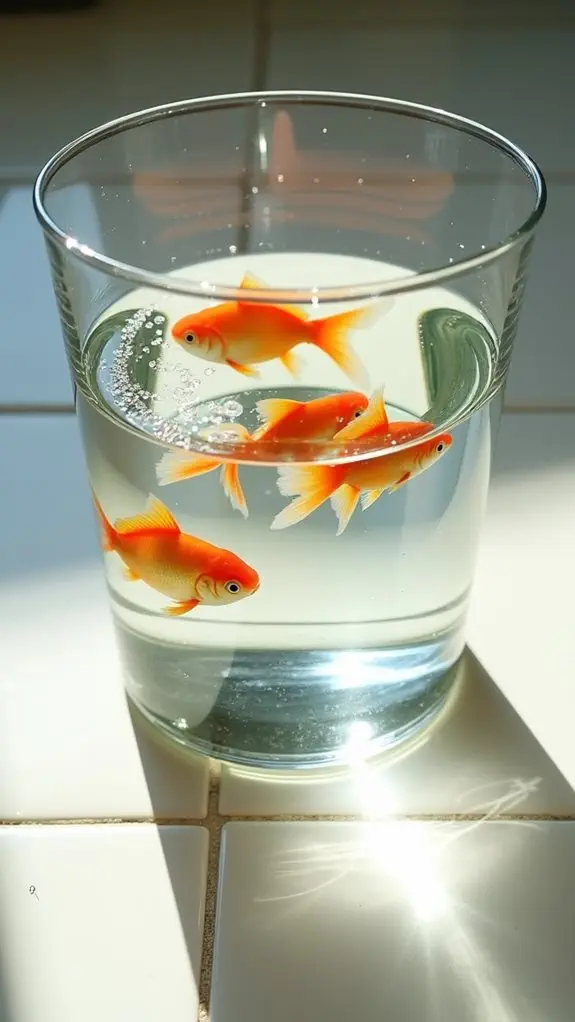
Three main factors determine how long you can safely keep goldfish in a bucket: water quality, oxygen levels, and stress management. While you might need to use a bucket in emergencies, it's important to understand that this setup should only be temporary – ideally no more than a few days at most. Adding live plants can help absorb waste and create a more stable environment for your goldfish. Regularly checking the water quality parameters will help you identify any imbalances that could harm your fish.
Your goldfish's size plays an essential role in how long they can safely stay in a bucket. Larger fish create more waste and use more oxygen, which means you'll need to be extra vigilant with bucket maintenance tips like frequent water changes and proper aeration. Using a clear plastic container can help you better monitor your fish's condition during temporary housing.
To minimize temporary stress factors, make sure you're using an airstone or sponge filter to keep oxygen levels stable. You'll want to watch your fish closely for signs of stress, such as rapid breathing or unusual swimming patterns. Make sure to test for critical parameters like ammonia and nitrite regularly to preempt any potential toxicity issues.
Think of it like keeping someone in a small room – it's okay for a short while, but nobody wants to live there permanently! Remember to check water parameters daily, and don't forget that your goal should be getting your finned friend back into a proper tank as quickly as possible.
Water Quality Requirements
Maintaining proper water parameters becomes even more critical when keeping goldfish in a bucket's confined space. You'll need to pay extra attention to water chemistry since waste products can build up much faster in a smaller volume.
Your goldfish's health depends on keeping the pH between 7.0 and 8.0, while ensuring ammonia and nitrites stay at zero. Without proper bucket filtration, you'll find it challenging to maintain stable parameters. Liquid test kits provide the most accurate readings for monitoring these crucial parameters.
The water's GH should stay between 100-300 ppm, and KH between 70-140 ppm – think of these as your goldfish's mineral comfort zone! You'll want to check the temperature regularly too, keeping it between 65-75°F, since buckets can heat up or cool down quickly. Adding SeaChem Prime to tap water during changes will help neutralize harmful substances.
Let's face it – keeping pristine water quality in a bucket isn't a walk in the park. You'll need to test the water daily and perform more frequent water changes than you'd in an aquarium.
Space and Size Considerations
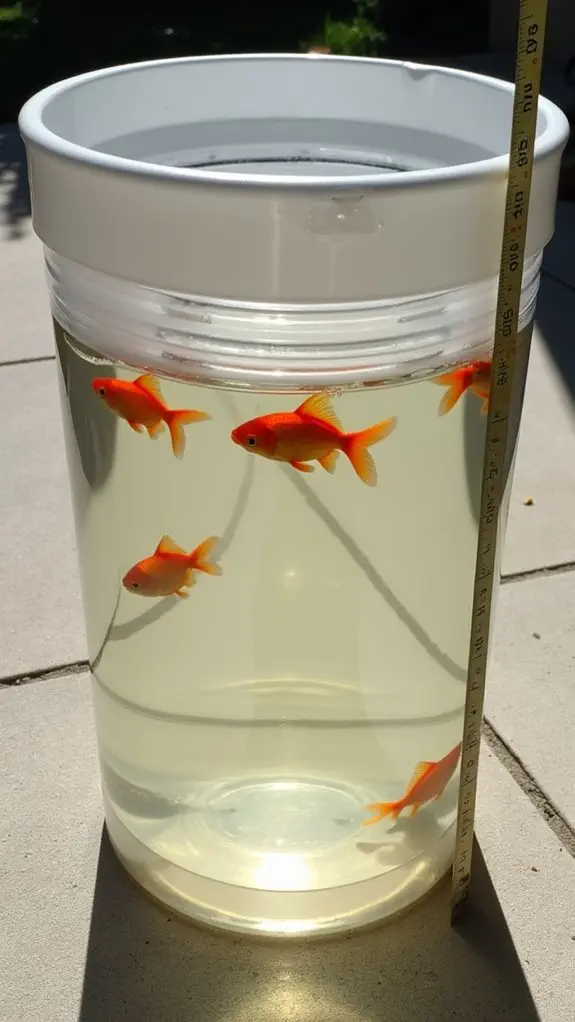
Space plays an essential role in your goldfish's wellbeing, with experts recommending at least 20 gallons of water for one fish and an additional 10 gallons for each extra goldfish.
When you're considering temporary bucket storage, remember that your goldfish's size directly impacts how long they can comfortably stay there. You'll notice changes in goldfish behavior if they're kept in too small a space, as they need room to swim and maintain proper oxygen levels. Water pressure concerns increase significantly in deep buckets compared to wider tanks. Maintaining adequate water quality is particularly challenging in confined spaces.
Wider and squatter containers are ideal since squatter designs provide better swimming conditions for goldfish.
Here's what you need to know about space requirements:
- Your bucket size should allow at least 5 gallons of water per inch of goldfish length.
- Fancy goldfish need a minimum of 25 gallons in their permanent home.
- Common goldfish require even more space, with 55+ gallons recommended.
- Multiple fish need considerably more space to prevent stress and maintain water quality.
While a bucket might work for very short-term housing, it's essential to understand that it's not a suitable long-term solution.
Your goldfish could become stressed or even experience stunted growth if kept in confined spaces for extended periods.
Think of it like trying to exercise in a cramped closet – it's just not practical or healthy!
Emergency Bucket Setup Essentials
Along with proper space requirements, setting up an emergency bucket correctly is vital for your goldfish's survival. For bucket safety, you'll need to start with a clean plastic container that's never held harmful chemicals – your goldfish won't appreciate swimming in a bucket that used to store cleaning supplies!
Make certain to drill small holes in the lid for proper air flow and equipment placement. Consulting an experienced aquarist can help ensure you've set up your emergency transport system correctly. Using a food-safe bucket is essential for safely housing fish in emergency situations.
You'll want to fill the bucket about two-thirds full with water from your original tank, as this helps reduce stress on your fish. Don't forget to install a battery-operated air pump with an air stone – it's like giving your goldfish their own personal oxygen bar!
For proper emergency preparation, keep spare batteries handy, and remember to check on your fishy friends every 4-6 hours by opening the lid to verify everything's running smoothly.
While your goldfish are in their temporary home, resist the urge to feed them, as this helps keep the water cleaner.
If they need to stay in the bucket for more than 36 hours, you'll need to perform water changes to maintain good water quality.
Signs of Stressed Fish
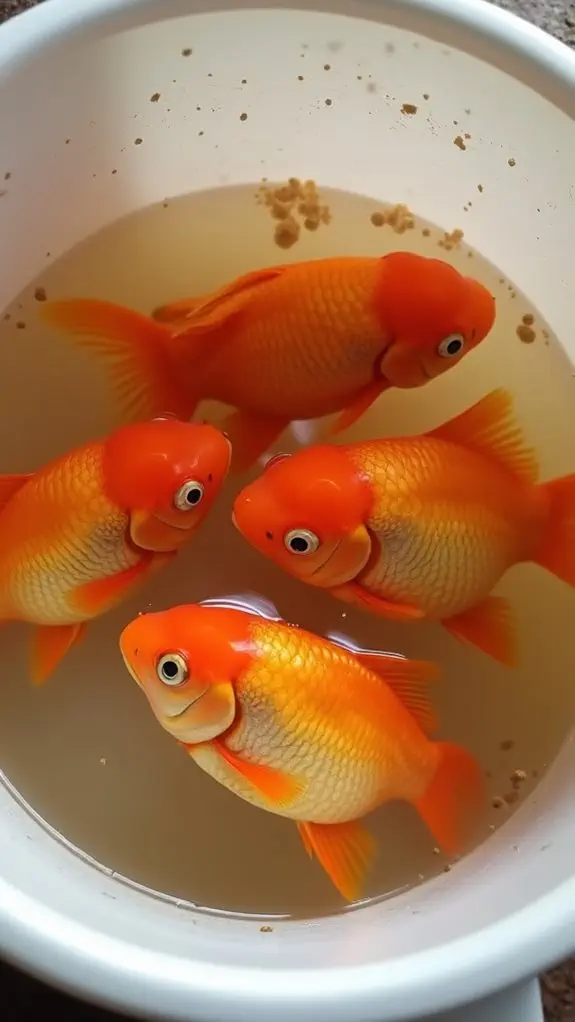
During your goldfish's stay in a bucket, watching for signs of stress is essential to prevent health complications. Your fish can't tell you when they're feeling under the weather, so proper stress management relies on your careful behavioral observations.
Here are the key stress indicators you'll want to monitor:
- Watch your goldfish's breathing patterns – if they're gasping at the surface or their gills are moving rapidly, they're likely experiencing oxygen stress.
- Notice changes in swimming behavior – stressed fish might dart around erratically or hang out at the bottom of the bucket more than usual.
- Pay attention to their appetite – if they're spitting out food or showing no interest in eating, it's a clear red flag.
- Look for physical changes like clamped fins (when fins are held close to the body) or color changes, which can signal distress. Regular testing of water quality helps ensure that your goldfish remains in a stable environment, minimizing additional stressors.
Poor water quality and rising ammonia levels can quickly lead to immune system suppression in goldfish. Regular water testing is crucial since poor water quality is a primary cause of fish stress.
If you spot any of these signs, you'll need to take action quickly.
Maintaining Proper Oxygen Levels
Oxygen management stands as the most critical factor when keeping goldfish in a bucket. To maintain proper oxygen saturation, you'll need to fill your bucket about 75-80% full, which gives you enough water volume while leaving space for essential aeration techniques.
Think of it as creating a comfortable underwater apartment for your finned friends!
For the best results, you'll want to equip your bucket with an air pump and air stone – they're like tiny oxygen factories for your fish. Position the air stone at the bottom of the bucket, where it'll create a lovely curtain of bubbles that distribute oxygen throughout the water.
If you're planning for potential power outages, a battery-operated pump can be your backup plan.
While breather bags are great for fish transport, buckets offer more stable conditions for temporary housing. Just remember to keep the water temperature steady between 72-76°F, and you'll want to avoid placing the bucket in direct sunlight. Maintaining these conditions also helps to prevent stress and health complications for your goldfish.
Keep an eye on your fish's behavior – if they're hanging near the surface gasping for air, it's time to boost that oxygen level pronto!
Feeding During Bucket Stays
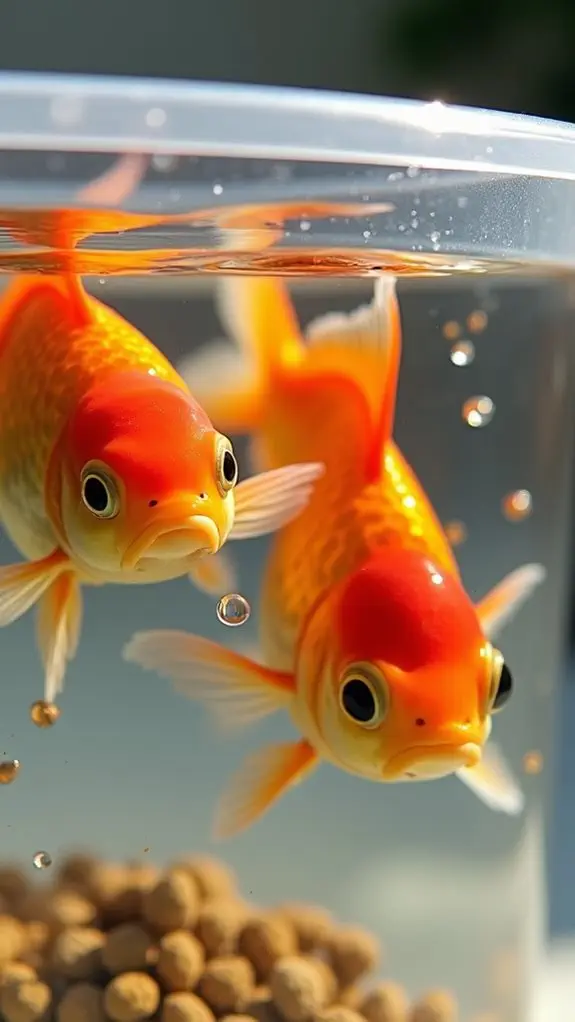
Proper feeding practices go hand-in-hand with maintaining good oxygen levels when keeping goldfish in a bucket. When it comes to your goldfish's temporary home, you'll need to adjust your feeding schedule to match their confined environment.
You don't want to overfeed them, as this can quickly compromise water quality in such a small space.
To keep your finned friend healthy during their bucket stay, follow these essential feeding guidelines:
- Break up feedings into multiple small sessions throughout the day, limiting each session to 1-2 minutes.
- Pre-soak dry food to prevent it from floating on the surface, which helps avoid swim bladder issues.
- Mix up food types by offering a combination of sinking pellets, gel foods, and pre-boiled vegetables.
- Only feed what your fish can consume in 5-6 minutes total per day.
Remember that goldfish are primarily herbivores with sensitive digestive systems. They actually need less food than you might think, especially in temporary housing. Additionally, keeping goldfish in buckets can stress them, so always ensure you have a proper tank setup for their long-term health and well-being, including regular water changes.
Alternative Housing Options
While a bucket serves as a quick fix for housing goldfish, several alternative options can provide better temporary accommodations for your aquatic pets.
When following proper fish transportation guidelines, you'll find that small tanks with plenty of plants can offer a less stressful environment for your finned friends.
If you're planning a temporary tank setup, you'll want to reflect on both the size of your fish and how long they'll need alternative housing.
A heavily planted smaller aquarium can work wonderfully, as it provides hiding spots that help reduce stress during the shift. You can also use portable filtration systems and heaters to maintain proper water conditions, just like you'd in a permanent setup. Additionally, make sure to monitor ammonia levels carefully, as toxic ammonia levels can arise in such setups without proper filtration.
For those living in apartments or condos, don't worry – you've got options too!
Contemplate setting up a compact aquarium that's specifically designed for smaller spaces.
Just remember to fast your fish for up to 48 hours before the move, and you'll want to monitor water parameters closely during their stay.
With proper planning and care, your goldfish can remain comfortable and healthy in their temporary home.
Frequently Asked Questions
Can Goldfish Survive in a Bucket During Power Outages?
Yes, your goldfish can survive in a bucket during power outages if you maintain proper oxygen levels through manual water agitation. Just monitor water temperature and use battery-powered air pumps for extended outages.
Should I Cover the Bucket With a Lid While Transporting Goldfish?
For transportation tips, you'll want to partially cover the bucket with a breathable lid. Don't seal it completely – leave space for oxygen. The lid benefits include preventing splashes while keeping your goldfish safe.
You shouldn't mix different fish species in one bucket due to fish compatibility issues. Even temporary tank mates can stress each other out, leading to aggression and water quality problems. Keep different species separated.
Will Adding Aquarium Plants to the Bucket Help Goldfish Survive Longer?
Yes, aquarium plants can help goldfish survive longer by maintaining water quality and reducing stress. They'll absorb waste, provide oxygen, and create hiding spots, but you'll need tough varieties that can withstand your goldfish's nibbling.
Does Bucket Material (Plastic vs. Metal) Affect Goldfish Survival Time?
You'll want to choose plastic over metal buckets for your goldfish. Plastic avoids metal corrosion issues that can cause toxicity. Food-grade plastic buckets are safer and won't leach harmful substances into the water.
Final Thoughts
While you can temporarily keep your goldfish in a bucket during tank maintenance or emergencies, you'll want to limit their stay to 2-3 hours ideally, or up to 24 hours maximum with proper setup. Remember, your finned friends need clean water, adequate space, and proper oxygen levels to stay healthy. If you're planning longer temporary housing, you'll want to contemplate getting a backup tank or large container with proper filtration.

